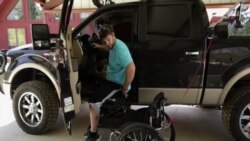Severe spinal cord injuries usually lead to total loss of control of lower extremities, as well as bladder, bowel and sexual functions. But scientists at the University of Louisville, Kentucky, say an implanted electrical device is helping the patients regain at least some of that control.
A dirt bike accident five years ago left Ken Stephenson paralyzed from the chest down. Doctors told him that he would never be able to stand up again.
“They said, based on what they've diagnosed and how I broke my back and everything, that I wouldn't be able to move my legs again or feel anything ever again,” said Stephenson.
Another blow to the young man was the loss of sexual function.
Now, however, thanks to a small device implanted in his back that electrically stimulates his spinal cord, Stephenson has regained some ability to enjoy activities he thought were left behind forever.
Dr. Roderic Pettigrew, of the National Institutes of Health, explained, “The goal was to modulate those damaged nerves in the spinal cord so that they once again could, would, become receptive to stimuli.”
The stimulator is turned on with a remote control and allows Stephenson to move one leg at the time. Other functions improved, too.
“The sexual function thing was huge for me because it was basically nothing before and, I mean, now, like, it's a lot better,” said Stephenson.
Three other patients reported similar improvements, although none of them can walk.
Pettigrew stresses that the device is not a cure and that more research is needed before it can be widely available. He said a spinal cord injury, though, may no longer mean a lifelong sentence of paralysis.
“What we see today with these four individuals now being able to have voluntary motion and voluntary control of their limbs and involuntary control of functions like bladder and bowel is very exciting,” said Pettigrew.
Researchers now plan to implant the device in eight more patients and try to stimulate more than one muscle group at the time.
A dirt bike accident five years ago left Ken Stephenson paralyzed from the chest down. Doctors told him that he would never be able to stand up again.
“They said, based on what they've diagnosed and how I broke my back and everything, that I wouldn't be able to move my legs again or feel anything ever again,” said Stephenson.
Another blow to the young man was the loss of sexual function.
Now, however, thanks to a small device implanted in his back that electrically stimulates his spinal cord, Stephenson has regained some ability to enjoy activities he thought were left behind forever.
Dr. Roderic Pettigrew, of the National Institutes of Health, explained, “The goal was to modulate those damaged nerves in the spinal cord so that they once again could, would, become receptive to stimuli.”
The stimulator is turned on with a remote control and allows Stephenson to move one leg at the time. Other functions improved, too.
“The sexual function thing was huge for me because it was basically nothing before and, I mean, now, like, it's a lot better,” said Stephenson.
Three other patients reported similar improvements, although none of them can walk.
Pettigrew stresses that the device is not a cure and that more research is needed before it can be widely available. He said a spinal cord injury, though, may no longer mean a lifelong sentence of paralysis.
“What we see today with these four individuals now being able to have voluntary motion and voluntary control of their limbs and involuntary control of functions like bladder and bowel is very exciting,” said Pettigrew.
Researchers now plan to implant the device in eight more patients and try to stimulate more than one muscle group at the time.










